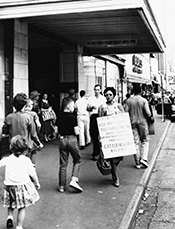|
Review of Passionate Politics: The Life and Times of Charlotte Bunch An Interview with Sharon La Cruise Review of Daisy Bates: First Lady of Little Rock |
||||
 |
||||
Daisy Bates picketing in Little Rock. Courtesy of Schomburg Center for Research in Black Culture, NYPL. |
||||
Journal Issue 4.2
We are drawn in to La Cruise's searching questions about the life of Daisy Bates, and in the process, students are able to be part of the messy, but at times exhilarating process of doing historical research. Reared in a small community in rural Arkansas, Daisy was eight years old when she learned that her mother had been raped and murdered by three local white men, her body dumped in a pond. Fearful of reprisals, her father left town leaving young Daisy in the care of another couple who raised her as their own. According to the friends and family that La Cruise interviews on camera, this deeply traumatic coming of age left Bates scarred for life.
La Cruise balances these personal recollections by friends with a scholarly analysis by historians including Dr. Aldon D. Morris at Northwestern University. Morris explains that while the rape and murder of her mother was no doubt formative to young Daisy, it was also a regular part of life for black girls and women in the pre-1964 South. All black women, he reminds us, lived with the constant threat of sexual assault and abuse by white men, and black men lived with the knowledge that there was little they could do to protect their own wives, sisters, and daughters. Sexual violence was part of the pattern of racial oppression in the South that black people had dealt with for centuries.
These kinds of harsh and unpleasant truths are vital to understanding not only the history of the black civil rights movement, but also the intricacies of gender-based discrimination within the movement. Part of what many black activists were fighting for was the right for black men to take their rightful place as heads of households with all the social and legal authority over women that position entailed. This ideal of manhood, which was embraced by many men and women in the movement, left little room for sharing power on an equal basis with women. Black women had to choose how to respond to the inherent sexism of the movement. Many agreed to pursue non-leadership roles that were out of the public eye, while others agreed to work as secretaries or assistants to male leaders. A few, like Bates, rejected both of these options and instead created their own opportunities for leadership. While this renegade strategy had the potential for success, it also came at a steep price as this film illustrates.
La Cruise's research uncovers details about Bates that would never make it into a standard US History textbook, such as the fact that young Daisy met her future husband when she was a girl of fifteen and he a married man of twenty-eight. Daisy ran off with L.C. Bates when she was eighteen and spent years drinking, dancing, and partying. La Cruise uses these details to show that Bates was not a part of the more established black middle class. As a young woman with only an eighth grade education and no real ties to Little Rock, she was looked down on by many people who viewed her as an outsider and a trouble maker. Yet according to La Cruise, these were the very traits that allowed Bates to rise to power within the inherently sexist infrastructure of the NAACP.
Bates ran for president of the Arkansas chapter of the NAACP in 1955, but was forced out by the national leadership which viewed her as an unsuitable candidate. Bates quietly withdrew and waited for two years until she saw a chance to run for the position unopposed. After seizing power, she used her position to force the issue of school desegregation in Little Rock. Citing the recent US Supreme Court case, Brown v. Board of Education of Topeka (1954), Bates recruited black families willing to send their children to white schools and then petitioned the superintendent to admit the black children. When he refused, she sued him on behalf of the NAACP and won. A local judge informed the superintendent that he would have to admit some black children to the all-white Central High School in the fall of 1957.
The debacle that unfolded at Little Rock is familiar to anyone with a basic knowledge of American history, but nevertheless La Cruise's focus on Bates reveals previously hidden aspects of this showdown. Chief among them is the fact that Bates acted more or less alone as she confronted the superintendent, rounded up black families willing to participate, and coordinated the children's lives for the next year. The local black community responded alternatively with suspicion, awe, and resentment to what they perceived was a one-woman show that too often seemed to place Bates's personal quest for glory above the best interests of the nine black students at Central High. In fact, Bates deliberately cut the students' families out of nearly every interaction with the school, apparently because she did not trust them to do what she wanted them to, and at the same time she staged newspaper and television interviews that catapulted her to national fame.
Copyright © 2014. All rights reserved.